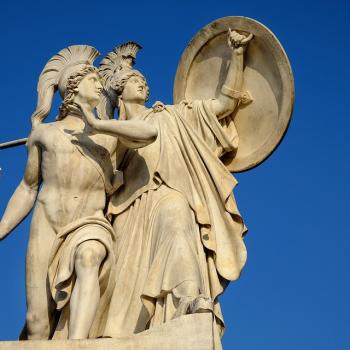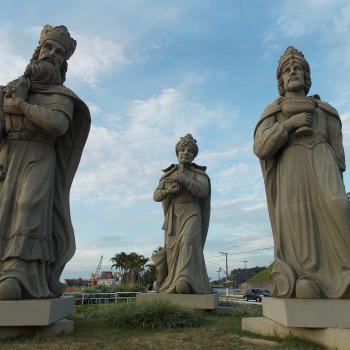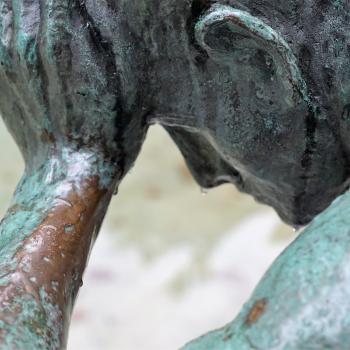
When we study the beginnings of the Church, we face first of all the shock that the world exhibited when they heard the gospel message. What?? A crucified King? What kind of upside-down story is this? We want a god who is powerful, not weak; victorious, not defeated; regal, not spit upon. And resurrected? Yeah, yeah, yeah. Not really, right? Just ritualistically? Wait, you mean, really?
(Note to those who argue that Jesus wasn’t physically raised from the dead: No one would have had a problem with a story about a “spiritual experience of a risen Jesus.” That would have been easily assimilated into a world that had a plethora of stories like that. The scandal was the insistence that a real, live Jesus walked out of that grave, physical enough to share a meal, cook breakfast on a beach, and take a walk with you.)
And then we face the confusion that the world felt about the community and its actions. Notably, they were the ones who acted counterculturally – they protected children and rejected infanticide; they honored marriage and protected women; they cared for the sick, the abandoned, the poor; they shared their wealth; they took care of their own. And most odd of all, they were downright inflexible about their Jesus, and would rather be burned like a torch or be ripped apart by wild animals or be crucified or beheaded or sold as a slave than to turn away from Christ.
One example, young Perpetua, 22 years old, nursing her baby, believing. She would have been spared by a simple word, even if spoken with her fingers crossed behind her back, of worship for the pagan gods. Think of her baby! Think of her duty as a mother! And yet she surrendered her baby son, and chose instead to be gored by a wild bull. Nearly incomprensible.
But then there was another wave of confusion. The message. The people. And then, the Church. What was going on? There was this fellowship, defined by the message and practiced by the people, but the fellowship itself was something more.
This fellowship entailed two dimensions, an interior and an exterior, not unlike a marriage. A good marriage has a strong interior dimension, which consists of mutual love and commitment, common goals, stewardship of property and, when applicable, joint care for children. Like a mosaic, the picture comes together with flecks of color: innumerable conversations, arguments, errands, meals, vacations, chores, making love, sharing books and music and movies, care, and compassion.
A good marriage also has a strong exterior dimension, which consists of exclusivity, loyalty, financial support, community engagement, household arrangements, larger family relationships, duties to neighbors and common friends, legal obligations. And all this, too, comes together in bits and pieces, all herky-jerky as two people overcome one obstacle after another to join their lives to each other.
And so, the Church in those early centuries had to develop an interior and an exterior.
The question – for the fellowship itself and for the watching world – was, What is the Church? And out of that primary question, there were two sub-questions:
1) What does it mean to belong to this fellowship? And
2) How does this fellowship relate to the rest of the world?
The early Church struggled mightily with these two questions; the former is a question of purity, the latter a question of politics.
The first question was expressed in ways like these: Who’s in and who’s not? Why? What do we who belong to this fellowship believe? How do we practice those beliefs? Where’s the center? What are the peripheries? How far can we stretch them before they’re no longer the peripheries of anything at all? Perpetua may be a model of heroism and virtue, but we aren’t all like her. What happens to people who make less stellar choices, but they want to belong to this fellowship. Are they okay? How do we know?
And the second was expressed with these sorts of questions: What should the world see when it looks at us? How will we organize ourselves so that all those in the fellowship are properly connected? By what standards shall we measure our purity? Our practice? How do we engage the world? Can we go to the chariot races? The circus? Can we be soldiers? Actors? Musicians? Can we be merchants? Can we own property? Should we dress differently?
The 21st-century Church is still wrestling with these questions. Boundaries and beliefs; institutions and practices; membership and meaning and ritual and engagement. This business of the Church is messy and fluid and fitful and unpredictable and disappointing and exhilarating. It’s more than the institution, but not less than it. It’s more than the sum of its people, living and dead, but cannot be explained by the lives or actions of those people, even if you told every single story of every single believer since Christ’s ascension.
We are Radicals (those more concerned with the political question) and Traditionalists (those more concerned with the purity question). Radicals can look tattooed and pierced and postmodern and edgy, or Radicals can wear bonnets and drive in buggies and live in communities and share their property. Traditionalists can look like suburban soccer moms and Wall Street businessmen or like clergy members in robes and pointy hats. What on earth binds us all together?
You answer that.













